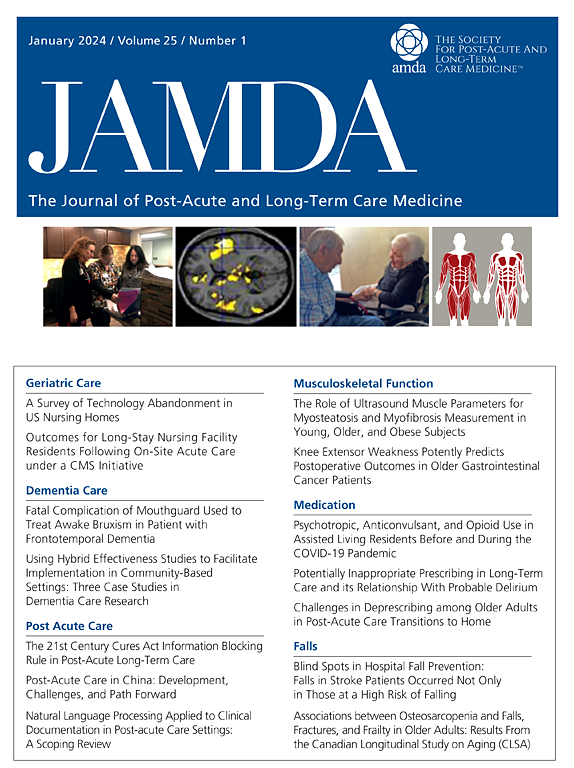安大略省生活辅助之家的医疗服务提供者参与情况:描述性横断面调查分析。
IF 4.2
2区 医学
Q2 GERIATRICS & GERONTOLOGY
Journal of the American Medical Directors Association
Pub Date : 2024-10-15
DOI:10.1016/j.jamda.2024.105309
引用次数: 0
摘要
目标:辅助生活在安大略省不断发展。在安大略省,医疗服务不受监管,因此医生的参与程度也不尽相同。我们描述了生活辅助设施中医疗服务提供者的参与情况和实践特点:设计:描述性横断面研究:加拿大安大略省共有 88 家生活护理院在 2023 年接受了调查:管理者回答了有关招聘各种医疗专业人员、他们在养老院的参与情况、可提供的支持、养老院的文件记录以及姑息治疗的可用性等问题。我们报告了调查项目的绝对比例和相对比例。我们使用回归分析法来评估在有和没有招募医疗服务提供者的养老院中,患者从社区获得护理的比例是否存在显著的统计学差异:54所(61.4%)养老院有医疗服务提供者,主要是主治医生。在 36% 的安老院中,主治医生照顾的病人超过 50 人,46% 的主治医生每周都会到安老院看望病人。据管理者称,医疗服务提供者的大部分时间用于提供预约服务、回复电话和传真、进行药物审查以及与住客家属进行讨论。近三分之二的安老院让护士陪同医生查房,并为医疗服务提供者提供诊所空间和设备。三分之二的安养院主要通过社区支持为住客提供姑息治疗。与没有招募医疗服务提供者的安养院相比,招募了医疗服务提供者的安养院居民在社区寻求医生护理的几率要低 75%(P < .001):我们的研究结果表明,辅助生活护理院在招募医疗服务提供者及其执业特点方面存在很大差异。居民可能会受益于现场可及和以患者为中心的医疗服务。这项研究为安大略省未来的辅助生活研究提供了背景信息,并可与其他省份和国家的政策进行比较。本文章由计算机程序翻译,如有差异,请以英文原文为准。
Medical Care Provider Involvement in Ontario Assisted Living Homes: A Descriptive Cross-Sectional Survey Analysis
Objectives
Assisted living is growing in Ontario. Medical services are not regulated in Ontario, resulting in variability of physician involvement. We described medical service provider involvement and practice characteristics in assisted living homes.
Design
Descriptive cross-sectional study.
Setting and Participants
A total of 88 assisted living homes in Ontario, Canada, which responded to a survey in 2023.
Methods
Administrators responded to questions on recruiting various health professionals, their involvement in the retirement home, support available, documentation in the home, and availability of palliative care. We reported absolute and relative proportions for survey items. We used regression analysis to assess if there is a statistically significant difference in the proportion of patients accessing care from the community in homes with and without a recruited medical service provider.
Results
Fifty-four (61.4%) of homes had a medical service provider, primarily an attending medical doctor. Attending medical doctors cared for more than 50 patients in 36% of homes, and 46% visited homes weekly. Administrators reported that medical providers spent most of the time providing appointments, responding to phone calls and faxes, conducting medication reviews, and discussing with residents’ families. Nearly two-thirds of homes had nurses accompany physicians on rounds and provided medical service providers with clinic space and equipment. Two-thirds of homes provided residents with palliative care, primarily through community support. Residents of homes with a recruited medical service provider had 76% lower odds of seeking care from their physician in the community than those without a recruited provider (P < .001).
Conclusions and Implications
Our findings describe high variability in recruiting medical service providers in assisted living homes and their practice characteristics. Residents may benefit from on-site accessible and patient-centered medical care. This study provides contextual information to inform future research on assisted living in Ontario and enables policy comparisons to other provinces and countries.
求助全文
通过发布文献求助,成功后即可免费获取论文全文。
去求助
来源期刊
CiteScore
11.10
自引率
6.60%
发文量
472
审稿时长
44 days
期刊介绍:
JAMDA, the official journal of AMDA - The Society for Post-Acute and Long-Term Care Medicine, is a leading peer-reviewed publication that offers practical information and research geared towards healthcare professionals in the post-acute and long-term care fields. It is also a valuable resource for policy-makers, organizational leaders, educators, and advocates.
The journal provides essential information for various healthcare professionals such as medical directors, attending physicians, nurses, consultant pharmacists, geriatric psychiatrists, nurse practitioners, physician assistants, physical and occupational therapists, social workers, and others involved in providing, overseeing, and promoting quality

 求助内容:
求助内容: 应助结果提醒方式:
应助结果提醒方式:


